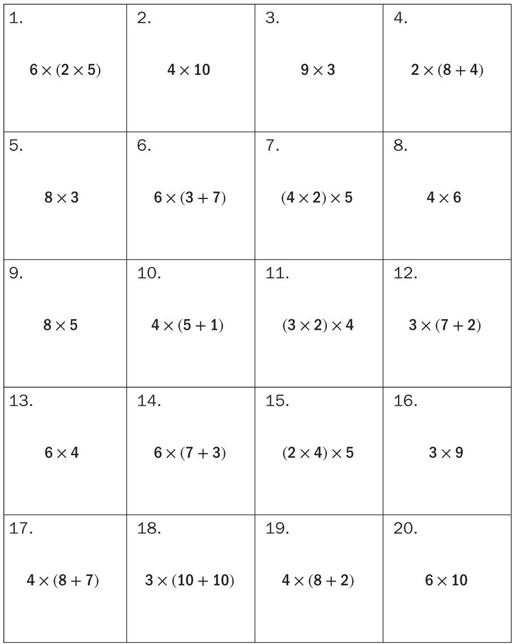Read Teaching the Common Core Math Standards With Hands-On Activities, Grades 3-5 Online
Authors: Judith A. Muschla,Gary Robert Muschla,Erin Muschla-Berry
Tags: #Education, #Teaching Methods & Materials, #Mathematics, #General
Teaching the Common Core Math Standards With Hands-On Activities, Grades 3-5 (5 page)

Cards that equal 60: 1, 6, 14, 17, 18, and 20. Cards that equal 40: 2, 7, 9, 15, and 19. Cards that equal 27: 3, 12, and 16. Cards that equal 24: 4, 5, 8, 10, 11, and 13.
Fact Cards
Operations and Algebraic Thinking: 3.OA.6
“Understand properties of multiplication and the relationship between multiplication and division.”
6. “Understand division as an unknown-factor problem.”
Background
Since division and multiplication are inverse operations, every division problem has a related multiplication problem.
For example, can be posed as “3 times what number is 18?” Students can solve this problem by finding the missing factor of 18.
can be posed as “3 times what number is 18?” Students can solve this problem by finding the missing factor of 18. The missing factor is 6.
The missing factor is 6.
Activity: Number Scramble
Working in pairs or groups of three, students will be given a division problem. They will find the number that completes a multiplication sentence and then find the missing factor.
Materials
Scissors; glue sticks; one copy of reproducibles, “Multiplication, Division, and Factors, I” and “Multiplication, Division, and Factors, II,” for each pair or group of students.
Procedure
1.
Hand out copies of the reproducibles. Note that “Multiplication, Division, and Factors, I” contains six rows (1 through 6) and that “Multiplication, Division, and Factors, II” contains four rows (7–10). Each row is divided into three parts. The first part contains a division problem. The second part contains a related multiplication sentence that students must complete. The third part contains the answer to the multiplication sentence, which students must provide. Following row 10 is a Number Bank.
2.
Explain that students are to cut out the numbers in the Number Bank. They are to glue the correct numbers in the boxes to complete the multiplication sentences. They are also to glue the correct numbers in the boxes for the answers to the multiplication sentences. Note that each multiplication sentence is related to the division problem in its row.
Closure
Discuss students' results. While still working in pairs or groups, for more practice, ask your students to write a division problem for their partners. Their partner should then write a related multiplication sentence.
Answers
The missing numbers in each row follow:
(1)
5, 5, 25;
(2)
6, 4, 24;
(3)
3, 2, 6;
(4)
3, 3, 9;
(5)
2, 4, 8;
(6)
8, 5, 40;
(7)
3, 9, 27;
(8)
5, 6, 30;
(9)
8, 3, 24;
(10)
6, 9, 54
Multiplication, Division, and Factors, I
Multiplication, Division, and Factors, II
Operations and Algebraic Thinking: 3.OA.7
“Multiply and divide within 100.”
7. “Fluently multiply and divide within 100, using strategies such as the relationship between multiplication and division (e.g., knowing thatone knows that
) or properties of operations. By the end of Grade 3, know from memory all products of two one-digit numbers.”
Background
The first step to mastering multiplication and division is to understand how these operations are related. The next step is to be able to multiply and divide quickly and accurately all products of two one-digit numbers. This is achieved through practice and memorization.
Activity: Multiplication and Division Bingo
Students will create a math bingo board by placing numbers from a Number Bank in each square on the board. The teacher will call out multiplication and division problems. If the answer is on the student's board, the student will cover the square with a counter. The first student to cover the squares in a row, column, or diagonal is the winner.
Materials
24 1-inch diameter (or smaller) counters; reproducible, “Multiplication and Division Bingo,” for each student. Optional: One copy of reproducible, “Problem Bank for Multiplication and Division Bingo,” for the teacher.
Procedure
1.
Hand out copies of the bingo boards. Explain that there is a Number Bank below the board.
2.
Explain that students should randomly fill in each square on their board with a number from the Number Bank. They should not fill in the free space with a number. As they fill in a number, suggest that they cross out the number in the Number Bank so that they will not use the same number twice. Note that some numbers will not be used.
3.
Explain the rules of the game. You will call out a multiplication or division problem from the “Problem Bank for Multiplication and Division Bingo.” (
Note:
The answers are written in parentheses after the problems.) Students who find the answer to the problem on their boards should place a counter on the number. (
Note:
Having students use counters to place on numbers allows you to use the same bingo board for additional games.) After presenting a problem, place a check beside the problems you use on the Problem Bank so that you do not use the problem again. Continue calling out problems until a student gets bingo.
4.
Check the answers the student has covered on his bingo board to make sure he is correct.
Closure
Announce the correct answers and review any problems that students found confusing.
Multiplication and Division Bingo



